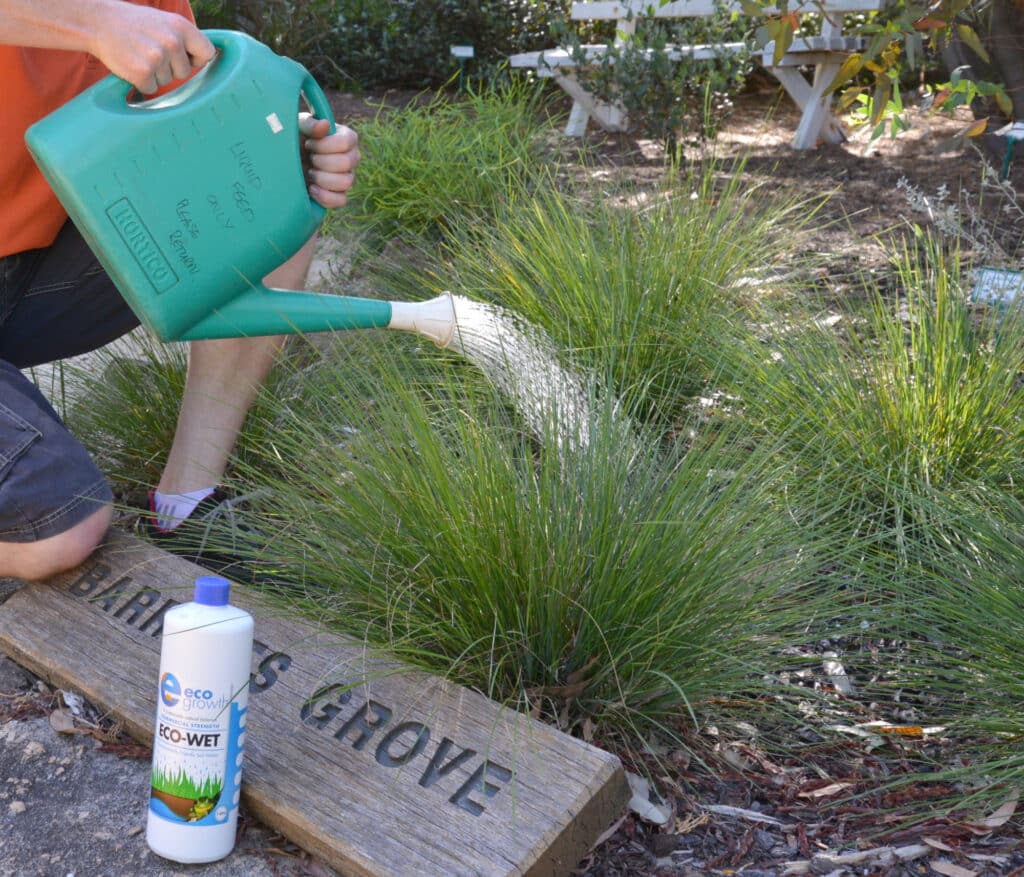Menu
Opening Hours: 9am-5:30pm, Every day except closed on Christmas Day and Boxing Day.
Opening Hours: 9am-5:30pm, Every day except closed on Christmas Day and Boxing Day.

Plants grown in a nursery environment receive 10-14mm of water, everyday in summer and every second day in the other three seasons unless unusually hot, windy or raining. This water is applied slowly over 1.5 hours so that it can soak in.
When you take your new plants home, you want to try to replicate theenvironment it was growing in until it can develop its root system. Generally this means a good soak every day in summer for 4 to 6 weeks depending on soil conditions and position (see factors below). Every second day in autumn to spring
unless exceptionally hot, windy or raining.
Here are a few factors to consider that affect the amount of water a plant needs:
• Sandy soils don’t hold as much water as heavier soils and can also be hydrophobic. This means the water will be reluctant to soak in to the root zone and you may need to apply a soil wetter. To test your soil, build a saucer of soil and fill with water, time how long it takes to soak through. Ideally it should only
take a few seconds to soak in. Clay and organic matter can be added, and this will help to hold more water in the root zone.
• If you are in an area that is very windy, this can dry out plants, pots and hanging baskets. Extra water may need to be applied on windy days. You can also try planting hedges or creating a screen to remove some of the wind tunnelling.
• Some plants can grow in a full sun position if they receive extra summer water. In a dappled sun or half day sun position the same plant will require less water.
• Improve the soil with soil improver to hold more water. Any organic matter will help the plant to survive better through the warm dry months. You can mix in Soil Improver to a ratio of up to 50/50 with existing poor sandy soil, but any amount mixed in will help.
• Plant choice makes a big impact on how much water the garden requires. Try grouping plants together with their water requirements.
• The size of a plant purchased will also make a difference, as a small plant’s root ball will dry out much quicker so will need more frequent watering. You may like to offer the small plant some temporary protection from the sun in the form of a tree guard.
• Mulch will help keep the water in the soil rather than evaporate into the air. It also helps to keep the root zone cool which protects the soils microbes. Choose a coarse large particle mulch like chunky Pinebark that will let the water soak through into the soil.
• Fertilise less, especially going into summer. Plants that have more fertiliser for growing will also require more water. If they don’t get the water they need they can sustain fertiliser burn and perish.
Signs of under watering for most plants is the new growth will wilt and then the foliage will go brown and crispy. Signs of overwatering is similar as the roots rot they can no longer suck up the water that is available, but may drop old leaves first as some of the roots are still functioning. For over watering and root rot, it is most common when the water does not drain away. Like in a pot plant where the drainage hole becomes blocked, or in heavy clay soils through winter.
TIP: When planting out your new plants, it is worth giving them a good soak before planting. You can even soak the planting hole with a solution of Eco Wet before putting the plant in. There are products like Seasol that will help the plant with transplant shock and encourage strong root growth. You can mix this in when planting and apply once a month for new plants.
Note: This is a guide only, and every position needs its own consideration with how much water a plant needs. If you have any questions give the nursery a call and we will be happy to talk through your situation.
We love your feedback, please review us on Google

“Zanthorrea Nursery has been an accredited nursery and garden centre for many years, and is active in supporting Greenlife Industry Australia and the Nursery and Garden Industry of WA”
